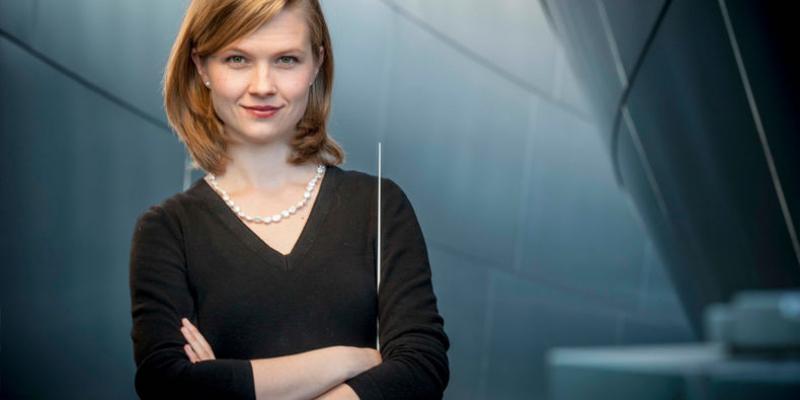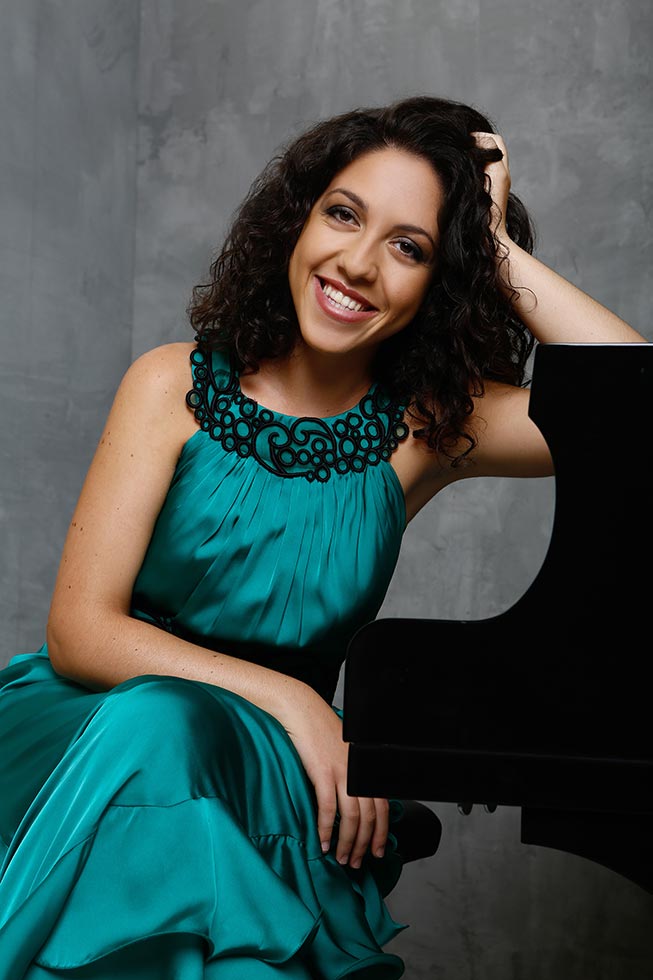Rana, CBSO, Gražinytė-Tyla, Symphony Hall Birmingham | reviews, news & interviews
Rana, CBSO, Gražinytė-Tyla, Symphony Hall Birmingham
Rana, CBSO, Gražinytė-Tyla, Symphony Hall Birmingham
Colourful Sibelius and selfless Schumann as Birmingham seeks a new music director

As pianist Beatrice Rana ran up the final bars of Schumann’s Piano Concerto, the conductor Mirga Gražinytė-Tyla turned to her soloist and simply beamed. As well she might. Rana is an artist whose advance publicity belies the seriousness and selflessness of her playing.
Rana’s performance was more concerned with counterpoint than colour; a brisk, earnest, intensely sincere approach which let Schumann’s poetry speak for itself. And with Gražinytė-Tyla and the City of Birmingham Symphony Orchestra in alert, warm-hearted support, that was enough to release one of the most unaffectedly musical performances of this concerto we’ve heard. In any other concert, it would have been the main talking-point (Rana pictured below by Marie Staggat)
But it’s no secret that the CBSO is currently searching for a new music director, and it’s been known since last summer that Gražinytė-Tyla is – at the very least – under serious consideration. This concert was arranged at short notice outside of the orchestra’s main season; that alone – plus the fact that a further concert has quietly been arranged next weekend with the young Israeli conductor Omer Meir Wellber (online rumours that another Israeli, Lahav Shani, is still in consideration can be discounted) - couldn’t help but create an atmosphere of expectation.
 What Gražinytė-Tyla achieved, then, was all the more remarkable. Her ultra-precise beat and balletic podium manner have attracted unfavourable comment from people who fundamentally misunderstand how an orchestra responds to a conductor – or who simply can’t listen. That Gražinytė-Tyla has a distinctive vision – and the power to realise it – was obvious from the rapturous opening bars of Debussy’s Prélude à l’après-midi d’un faune in which she coaxed the strings to match both the colour and texture of Marie-Christine Zupancic’s daringly-soft opening flute solo, and went on to generate an unfolding sense of wonder in which even the rests felt like part of the phrasing: hanging, pregnant with expression, in a breathlessly quiet Symphony Hall.
What Gražinytė-Tyla achieved, then, was all the more remarkable. Her ultra-precise beat and balletic podium manner have attracted unfavourable comment from people who fundamentally misunderstand how an orchestra responds to a conductor – or who simply can’t listen. That Gražinytė-Tyla has a distinctive vision – and the power to realise it – was obvious from the rapturous opening bars of Debussy’s Prélude à l’après-midi d’un faune in which she coaxed the strings to match both the colour and texture of Marie-Christine Zupancic’s daringly-soft opening flute solo, and went on to generate an unfolding sense of wonder in which even the rests felt like part of the phrasing: hanging, pregnant with expression, in a breathlessly quiet Symphony Hall.
Sibelius’s four Lemminkäinen Legends made good on the Debussy’s promise. Gražinytė-Tyla has a powerful sense of the single culminating point of a large-scale musical structure, and the idea that these four tone-poems add up to a thinly-disguised symphony has rarely felt so convincing, with Gražinytė-Tyla reversing the conventional order of the two central pieces so that Lemminkäinen in Tuonela became a slow, macabre scherzo, and the dying notes of The Swan of Tuonela served as a sort of prelude to the first drumbeats of Lemminkäinen’s Homecoming. Throughout, Gražinytė-Tyla drew out and relished each fantastical detail of Sibelius’s scoring: snare-drum rattling against a pianissimo rustle of violins, the gurgling woodwind laughter of the maidens of Saari, and the impressionistic blur of sound that introduced Rachael Pankhurst’s tender, improvisatory cor anglais solo in The Swan of Tuonela.
And yet the pacing remained taut, the cumulative build-up and release of energy overwhelming – and the players, leaning into their stands and exchanging discreet smiles, seemed energised. They, rather than any manager or critic, will have the final say on their new music director, and it’s probably premature to expect any white smoke to emerge from CBSO Centre in the immediate future. What’s clear is that Gražinytė-Tyla has a lively intelligence, a commanding technique and – most importantly – a joyous natural musicality that in the right conditions could more than fill the shoes of Nelsons, Oramo and Rattle. Any orchestra would be lucky to have her.
rating
Share this article
Add comment
The future of Arts Journalism
You can stop theartsdesk.com closing!
We urgently need financing to survive. Our fundraising drive has thus far raised £49,000 but we need to reach £100,000 or we will be forced to close. Please contribute here: https://gofund.me/c3f6033d
And if you can forward this information to anyone who might assist, we’d be grateful.

Subscribe to theartsdesk.com
Thank you for continuing to read our work on theartsdesk.com. For unlimited access to every article in its entirety, including our archive of more than 15,000 pieces, we're asking for £5 per month or £40 per year. We feel it's a very good deal, and hope you do too.
To take a subscription now simply click here.
And if you're looking for that extra gift for a friend or family member, why not treat them to a theartsdesk.com gift subscription?
more Classical music
 Hallé John Adams festival, Bridgewater Hall / RNCM, Manchester review - standing ovations for today's music
From 1980 to 2025 with the West Coast’s pied piper and his eager following
Hallé John Adams festival, Bridgewater Hall / RNCM, Manchester review - standing ovations for today's music
From 1980 to 2025 with the West Coast’s pied piper and his eager following
 Kaploukhii, Greenwich Chamber Orchestra, Cutts, St James's Piccadilly review - promising young pianist
A robust and assertive Beethoven concerto suggests a player to follow
Kaploukhii, Greenwich Chamber Orchestra, Cutts, St James's Piccadilly review - promising young pianist
A robust and assertive Beethoven concerto suggests a player to follow
 Robin Holloway: Music's Odyssey review - lessons in composition
Broad and idiosyncratic survey of classical music is insightful but slightly indigestible
Robin Holloway: Music's Odyssey review - lessons in composition
Broad and idiosyncratic survey of classical music is insightful but slightly indigestible
 Classical CDs: Wolf-pelts, clowns and social realism
British ballet scores, 19th century cello works and contemporary piano etudes
Classical CDs: Wolf-pelts, clowns and social realism
British ballet scores, 19th century cello works and contemporary piano etudes
 Bizet in 150th anniversary year: rich and rare French offerings from Palazzetto Bru Zane
Specialists in French romantic music unveil a treasure trove both live and on disc
Bizet in 150th anniversary year: rich and rare French offerings from Palazzetto Bru Zane
Specialists in French romantic music unveil a treasure trove both live and on disc
 Scottish Chamber Orchestra, Ibragimova, Queen’s Hall, Edinburgh review - rarities, novelties and drumrolls
A pity the SCO didn't pick a better showcase for a shining guest artist
Scottish Chamber Orchestra, Ibragimova, Queen’s Hall, Edinburgh review - rarities, novelties and drumrolls
A pity the SCO didn't pick a better showcase for a shining guest artist
 Kilsby, Parkes, Sinfonia of London, Wilson, Barbican review - string things zing and sing in expert hands
British masterpieces for strings plus other-worldly tenor and horn - and a muscular rarity
Kilsby, Parkes, Sinfonia of London, Wilson, Barbican review - string things zing and sing in expert hands
British masterpieces for strings plus other-worldly tenor and horn - and a muscular rarity
 From Historical to Hip-Hop, Classically Black Music Festival, Kings Place review - a cluster of impressive stars for the future
From quasi-Mozartian elegance to the gritty humour of a kitchen inspection
From Historical to Hip-Hop, Classically Black Music Festival, Kings Place review - a cluster of impressive stars for the future
From quasi-Mozartian elegance to the gritty humour of a kitchen inspection
 Shibe, LSO, Adès, Barbican review - gaudy and glorious new music alongside serene Sibelius
Adès’s passion makes persuasive case for the music he loves, both new and old
Shibe, LSO, Adès, Barbican review - gaudy and glorious new music alongside serene Sibelius
Adès’s passion makes persuasive case for the music he loves, both new and old
 Anja Mittermüller, Richard Fu, Wigmore Hall review - a glorious hall debut
The Austrian mezzo shines - at the age of 22
Anja Mittermüller, Richard Fu, Wigmore Hall review - a glorious hall debut
The Austrian mezzo shines - at the age of 22
 First Person: clarinettist Oliver Pashley on the new horizons of The Hermes Experiment's latest album
Compositions by members of this unusual quartet feature for the first time
First Person: clarinettist Oliver Pashley on the new horizons of The Hermes Experiment's latest album
Compositions by members of this unusual quartet feature for the first time

Comments
We agree wholeheartedly. This
Also totally agree. I hope we